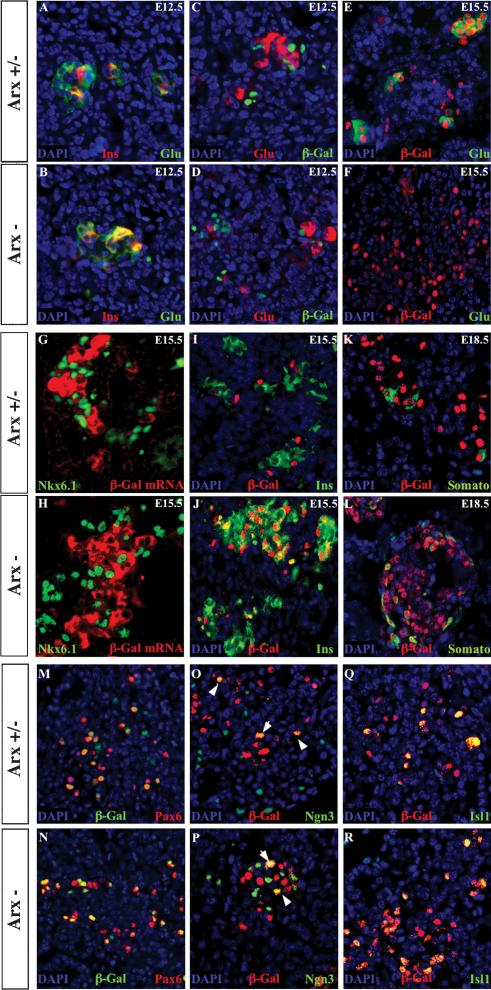Figure 5.
Alteration of mature endocrine cell-subtype specification following Arx inactivation. (A-D) Staining of E12.5 heterozygous (A,C) and mutant (B,D) Arx pancreata for insulin (A,B), glucagon (A-D), and β-galactosidase (C,D) proteins, counter-stained with DAPI (blue). β-galactosidase is not expressed in the early hormone-producing cells. There is no change in the number of insulin-expressing cells (often producing glucagon) following Arx deletion. (E-L) Sections of pancreas from E15.5 (E-J) and E18.5 (K,L) stained with anti-β-galactosidase (E,F,I-L), anti-glucagon (E,F), anti-Nkx6.1 (G,H), anti-DIG (G,H, shown in red), anti-insulin (I,J), or anti-somatostatin (K,L) antisera and counter-stained with DAPI (blue) in heterozygous (E,G,I,K) or mutant (F,H,J,L) animals except in G and H. (E,F) Glucagon-secreting cells coexpress β-galactosidase and are lacking in mutant pancreas. (G,H) β cells (stained with Nkx6.1 for technical reasons) do not express β-galactosidase in E15.5 mutant and control pancreas. (I,J) The β-cell population is increased in mutant islets. A residual presence of β-galactosidase protein is observed. (K,L) β-galactosidase staining is detected in δ cells, which are overrepresented in E18.5 Arx-deficient mice. (M-R) Endocrine differentiation appears normal following Arx inactivation. Sections of heterozygous (M,O,Q) and mutant (N,P,R) pancreas were stained with anti-Pax6 (M,N), anti-Ngn3 (O,P), or anti-Isl1 (Q,R) antisera together with anti-β-galactosidase antisera and counter-stained with DAPI (blue). (M,N) All β-galactosidase-labeled cells coexpress Pax6. Pax6-marked cells are normally represented in both genotypes. (O,P) Arrows show a few Arx- and Ngn3-labeled cells. Arx deletion does not alter the numbers of Ngn3-stained cells. (Q,R) Isl1-marked cells are exclusively found among the β-galactosidase-labeled population, but numerous cells are β-galactosidase+/Isl1-, suggesting a function of Arx in nonmature cells. Similar numbers of Isl1+ cells are observed in control and Arx mutant pancreas. Each picture is representative of at least three animals from different litters.

